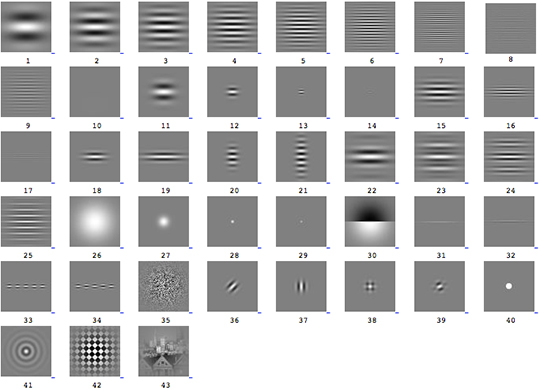|
|
 |

|
 |
 |
| ModelFest (Andrew B. Watson, Cesar Ramirez, Lindsay Kreslake) |
 |
What is ModelFest?
Since 1996, the annual meeting of the Optical Society of America has hosted a symposium entitled ModelFest. Conceived originally as a workshop in which those involved in the development of models of early human vision would demonstrate and discuss their work, it eventually adopted as part of its program the establishment of a public, communal set of data. The purpose of the data set would be twofold: 1) to calibrate and 2) to test vision models. The data set was required to be large and varied enough to adequaltely serve both purposes. It was also hoped that the complete data set would be collected by a number of different labs, to enhance both the generality and accuracy of the data set. Thus the data set was constrained to be small enough that a large enough number of labs would volunteer. Acting through consensus, the informal group decided upon an inital effort (Phase 1) consisting of 44 two-dimensional monochromatic patterns confined to an area of approximately two by two degrees.
Modelfest Stimuli
The image below shows the stimuli that was used used in Phase 1 of the ModelFest effort.

ModelFest Methods
Methods used during Phase 1 data collection were as follows:
Mean luminance = 30 cd/m^2 +- 5
Frame rate >= 60 Hz
Grayscale resolution: < 0.25 threshold
2IFC or Rating psychophysical procedure
Binocular viewing
Natural pupils
Time course of each stimulus should be a Gaussian with a standard deviation of 0.125 sec and a total duration of 0.5 sec.
120 pixels/degree raster resolution
image size = 256 x 256 pixels
Fixation marks = 2 pixel x 12 pixel "L" shaped corner marks just outside the 256x256 pixel stimulus field
Feedback provided
Enough trials to achieve expected standard errors of less than 0.1 log unit.
Thresholds reported should represent estimate of 84% correct point.
ModelFest Data
The ModelFest Baseline Dataset consists of four thresholds from each of 16 observers for each of 43 stimuli.
ModelFest Publications
- Watson, A. B. (2000). Visual detection of spatial contrast patterns: Evaluation of five simple models. Optics Express 6(1), 12-33 (link).
- Walker, L., Klein, S. A. & Carney, T. (1999). Modeling the Modelfest data: decoupling probability summation Proceedings, Optical Society of America Annual Meeting, Santa Clara, CA, OSA, pp. SuC5.
- Watson, A. B. & Ramirez, C. (1999). A standard observer for spatial vision based on ModelFest data Proceedings, Optical Society of America Annual Meeting, Santa Clara, CA, OSA, In press, pp. SuC6.
- Watson, A. B. & Solomon, J. A. (1999). ModelFest data: Fit of the Watson-Solomon model. Investigative Ophthalmology and Visual Science 40(4 (Supplement)), S572.
- Carney, T., Klein, S. A., Tyler, C. W., Silverstein, A. D., Beutter, B., Levi, D., Watson, A. B., Reeves, A. J., Norcia, A. M., Chen, C.-C., Makous, W. & Eckstein, M. P. (1999). The development of an image/threshold database for designing and testing human vision models Proceedings, Human Vision, Visual Processing, and Digital Display IX, SPIE, Bellingham, WA, 3644
|
|
|
|
|